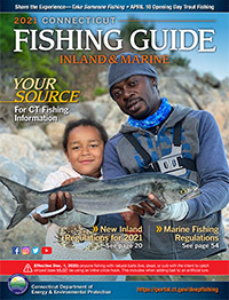Trout Maps
Trout fishing has a long and storied history in Connecticut. As one of the most popular fish, the majority of trout fishing is supported through production at one of our three state fish hatcheries. Each year over 100 lakes and ponds and 150 rivers and streams are stocked with trout. Due to their popularity, DEEP has implemented several strategies to provide high quality trout fishing to the greatest number of anglers.



Trout Management Areas
In an effort to improve trout fishing, several sections of rivers and streams have special regulations on season, creel limits, and size limits that vary from the statewide regulations. These regulations vary and can be found in this guide. These waters are also stocked with more and/or larger trout. Trout management regulations are designed to improve the fishing experience as they optimize fishing quality under heavy fishing pressure. Trout Management Areas (rivers/streams) are open to fishing year-round. A trout & salmon stamp is required to fish in a Trout Management Area.
Wild Trout Management
Wild trout (self-sustaining populations) are important renewable resource that add quality and diversity to Connecticut’s trout stream fisheries. Wild trout are often more colorful, feisty, and flavorful than stocked trout and are conserved through special regulations identified by Wild Trout Management Class. A trout & salmon stamp is required to fish in a wild Trout Management Area. Class 1 = Catch and release only, open year-round, use of a single-hook artificial lures or flies only. Class 2 = Two (2) trout per angler per day limit, trout must be 12” or larger to keep from opening day to last day of February. Class 3 = Five (5) fish per angler per day limit, trout must be 9” or larger to keep from opening day to last day of February.
Trout Parks
Trout Parks are located in easily accessible areas to enhance trout fishing opportunities for young anglers and novice anglers as well as for those with mobility challenges. The frequent stockings, generally between Opening Day and Memorial Day, will greatly increase an angler’s chance of catching a fish, making it a more attractive "fishing hole", particularly to children and families. The daily creel limit in trout parks is two (2) trout per person per day. A trout & salmon stamp is required to fish in a Trout Park.
Fishways/Fish Ladders And Fishing
Fishing is prohibited in the area immediately downstream or upstream of a fishway, generally for a distance of 250 feet from the fishway. Note that at some fishways, this distance may vary from 250 feet. At locations where the distance from the fishway does differ from 250 feet, the boundaries of the “no-fishing” area will be as posted by DEEP (look for signs and/or large rocks painted red marking the boundaries). Anglers with questions about the “no-fishing” zones around any of the over 60 fishways in the state should contact DEEP’s Diadromous Fisheries Restoration Program (Fisheries Division) at 860-434-6043.Find Connecticut Deep’s Interactive Trout Stocking Map At https://portal.ct.gov/DEEP/Fishing/General-Information/Trout-Stocking-Maps
An interactive map with near real-time information on stocked waters (including locations and the number of days since the most recent stocking event) and improved locational information about Connecticut’s trout stocked waters using the latest in mapping technology.
